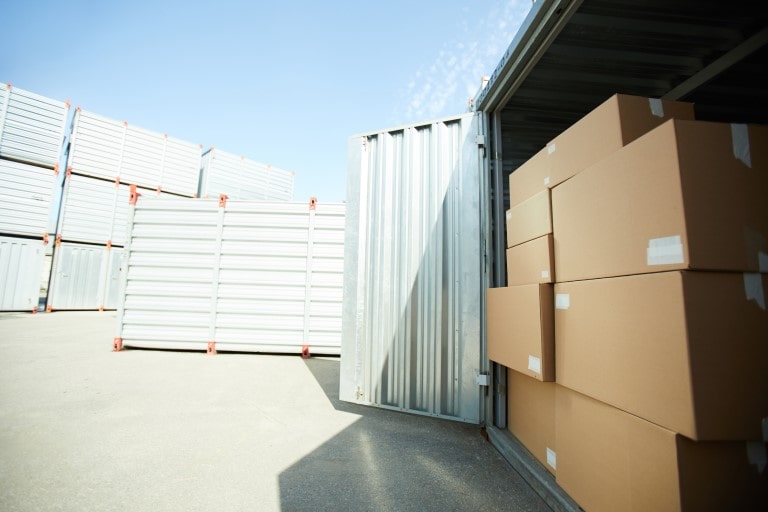A shipping container can come in a wide variety of sizes for international shipping and freight. Generally speaking these are 20 foot and 40 foot long containers that are 8 feet high and 8 feet wide (custom heights or open top containers are harder to find but also available if required). That’s a lot of space for transporting your precious cargo to it’s overseas destination.
In order to ensure that your cargo gets to where you want it, safely and securely – it’s important to pack and load the container correctly. It doesn’t matter whether you are moving your house contents to another country – or shipping your goods overseas for the export market. Even if you are moving interstate (from Brisbane to Perth for instance) – following our simple guide will make the task easier.
Your shipping container will be strongly built from solid sheets of steel, with a wooden floor to make for a level surface to pack everything on or make loading shipping containers with a pallet simple and straight forward. Usually it will be delivered to your property empty – allowing you to take your time while loading but sometimes, as is the case with a “live load”, the container will be on the back of a transport truck and the driver will wait for you to load it. It is most important to:
- Distribute the weight evenly across the shipping container
- Utilise the space effectively
- Place cargo in the proper places to prevent damage of goods
How to load a shipping container properly
1) Label your cargo & create a manifest

Make sure that all of your boxes are numbered, with a description of what is inside them written clearly on the outside. Try to keep only a single type of item in each box, and make sure that the description is clearly written (don’t use words like “stuff”, “general” and “things” as these may cause confusion and extra costs when clearing customs at an overseas destination).
Prepare a full written manifest of all boxes and make sure that all box numbers and descriptions match what is written on the manifest. There should also be a full “piece count” of all of your boxes at the end of the manifest. A clear manifest and well labeled boxes will ensure that your load clears customs quickly without added expense, or in the case of breakage, that it’s covered by your shipping insurance.
2) Distribute the cargo evenly

Place any heavy items on the floor of the container and lash them securely to the sides, furniture such as beds, mattresses and the like should be placed on their sides, preferably at the ends of the containers. Wooden furniture can be wrapped with blankets to keep it from being scratched or damaged by other items in the load.
Distribute the weight across the container and do not exceed the shipping container load capacity (referred to as the payload). You can work out the payload by subtracting the “tare” weight from the rated weight of the container (usually around 24,000 KG for a 20 foot container or 30,480 KG for a 40 foot container). Palletising or crating the cargo may make it easier to transport but will result in less space available for transport.
3) Use space effectively
To use the space effectively and try to fill the entire container from wall to wall. Fill any “free” space with padding (known as “dunnage” to shippers). A well packed container will keep everything in its place and prevent it moving about the container during transit. Straps are also a handy way of keeping cargo in its place. Don’t place cargo directly against the doors, instead use straps or a cargo gate if you need to.
4) Minimise cargo variation
When shipping goods overseas for export, its better to have as little variation as possible. For instance don’t mix wet and dry goods in the same container. If this is unavoidable, then place wet goods at the base of the container, that way if they are damaged during transit and leak they won’t damage dry goods (or at least damage will be minimised).
5) Shipping vehicles safely

Loading cars, motorbikes or other vehicles is also reasonably straight forward. First you’ll need to drain the fuel tank and disconnect the battery (for safety and regulatory reasons). Then push the vehicle into the container (or use a tow truck to back it in). You’ll want to make sure that any vehicles are at the front of the container near the doors, as the VIN numbers will need to be physically inspected at the port of import. Secure wooden blocks in front and behind the wheels to prevent the vehicle from rolling and use ratchet tie downs to lash the vehicle to the side of the container.
Cargo that is incorrectly packaged or loaded may incur additional costs if it raises the suspicions of customs, so make sure you do it correctly the first time to avoid additional customs charges when your container is X-Rayed at the point of entry.
Need a Shipping Container? Contact Us Now!

Do you need a shipping container to transport your products overseas or are you considering relocating for a new job or home? Contact Gateway Container Sales and Hire and talk to our team of shipping container experts. They will help you find the right container for the job – whether its a small 10 foot container, or an export quality 40 foot container to ensure that you get your stuff where you want it, safely and securely.




